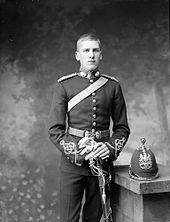The Royal Field Artillery was a branch of the Royal Artillery during World War War 1. There were two other branches of the Artillery during The Great War, The Royal Horse Artillery, the so-called elite branch of the Artillery; and the Royal Garrison Artillery, which mainly used the larger guns and developed 'technical' Gunnery (qv). The heavy guns were crucial to the final victory, as they had longer range and carried larger shells which were needed to destroy enemy fortifications.

The Royal Horse Artillery and the Royal Field Artillery were developed initially as battlefield units, operating at the front line, giving direct fire on the enemy lines, supporting infantry and cavalry attacks. Up to the First World War their mobility was considered to be one of their primary assets.
Even in the Boer War, the ability to manoeuvre quickly was considered to be a primary tactical advantage. These ideas about how to conduct War were primarily based on the experience of the Army during the Napoleonic Wars. However, Field guns had two serious disadvantages, power and range, which were relatively low in both cases. In a static war such as WW1, which was largely fought in trenches, the ability to fire heavy shells long distances became a crucial factor. However, most of the warring parties had little idea that this was to be the nature of this war at the beginning, and were thus nearly all short on the so-called 'heavy guns', and the tactics needed to utilise them efficiently.
Ww1 Rfa Drivers For Mac 2017
To illustrate the importance of the Artillery in bringing the War to victory for the Allies, the number of men serving in the Artillery grew from 93,000 in 1914 to 549,000 in 1918. In contrast, the Cavalry was reduced from a high of 132,000 in 1916 to 84,000 in 1918. These changes in personnel indicate that the command finally got to grips with the concept of modern industrialised warfare as the war progressed.
The combined use of all the forces available (Infantry, Aircraft, Artillery,Tanks, Gas Poison and Cavalry) was finally adopted in 1918 and led to the so-called 'last hundred days' which finally achieved victory. The intelligent co-ordination of artillery with these other forces was crucial to that victory. (Information from: Learning curves and Opportunity curves on The Western Front by Mike Senior, from Stand To! 93, Western Front Association). All members of the Royal Artillery are Gunners, from the highest ranking to the lowest. The rank of Gunner is assigned to the equivalent of Private in the Infantry, who is a member of a Gun crew; similarly, Bombardier is equivalent to Corporal.
A Driver sat astride the left horse in a pair of horses within the team of six horses which pulled the gun. Therefore, there would be three Drivers per gun. All other ranks are similar to those of the Infantry, with a few additional trade specific ranks like Shoeing-smith, wheeler, and fitter.
Officers needed to be clever rather than rich (as was the usual prerequisite for the more elite Regiments), as technical skills were required for accurate deployment of the guns; ability in Mathematics and Geography were valued more highly than social connections and skill on the hunting field (though these did help as well). The Regiment was divided into Brigades, and were numbered to identify each functioning unit. At the beginning of the War each Brigade was attached to a Division (Henry's Brigade was the 277th Brigade of the 55th West Lancashire Division TF), but in 1917 the Royal Artillery was re-organised and many units became came under the command of a centralised Command structure. Brigades were divided into Batteries commanded by an officer (theoretically a Major, if one was available), each Battery having four, six or eight guns. There were normally (but not always) four batteries in each Brigade, three with 6 eighteen pounder guns and one 6 piece howitzer battery. A Gun is the modern name for a cannon.
It has a long barrel and is used for firing high-velocity shell. It's trajectory is relatively low. The eighteen pounder gun, common to most batteries, was designed to be a mobile offensive weapon, and thus it was transported between positions by being hooked up to the back of a Limber (shell carrying trailer), which was in turn, pulled by a team of six horses.
Ww1 Rfa Drivers For Macbook Pro
Three of the horses of the team had a member of the crew on it's back, called a driver. They controlled the horse they were mounted on and the horse next to it.